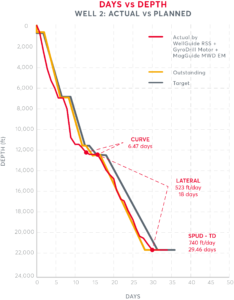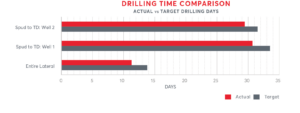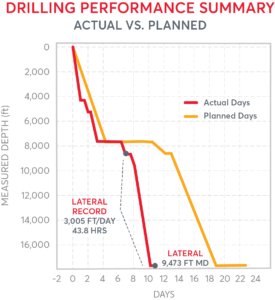Rotary steerable technology helps operators to beat AFE timelines in Granite Wash, Midland Basin wells
Point-the-bit RSS proves value in drilling of complicated wellbore trajectories in harsh environments, saves 8 days of drilling in one well’s lateral section
By John Evans and Brian Jansky, Gyrodata
One of the most significant drilling advancements in the petroleum industry in recent years has been the development of rotary steerable systems (RSS), which have proven valuable for directional and horizontal drilling.
The first commercial use of Gyrodata’s RSS tool was in 1993. At that time, it was called an automated guidance system.
These systems use specialized downhole technologies to replace conventional directional tools, such as mud motors.
RSS technology allows guidance of the well trajectory while the drill string continuously rotates. This eliminates the need for an operator to slide a mud motor to steer the well. These systems often employ automatic drilling modes such that the wellbore is automatically steered using a closed-loop system that is programmed in the downhole tool.
One advantage of continuous rotation when comparing automated drilling (RSS) with conventional directional drilling (mud motor) is the time drillers save by not having to orient the motor after drilling down each stand of drill pipe.
The methods that operators use to direct the well path with RSS technology can be primarily categorized as either push-the-bit or point-the-bit. Push-the-bit tools use pads on the outside of the tool that press against the wellbore, causing the bit to press on the opposite side, which results in a directional change. Point-the-bit technologies cause the direction of the bit to change relative to the rest of the tool by deflecting the main shaft that runs through it. Point-the-bit tools require non-rotating housing or reference housing in order to create this deflection within the shaft. The benefit of this type of tool is that it does not have to rely on the wellbore condition or formation integrity.
Benefits of RSS
Both geoscientists and drillers have found RSS technology to be beneficial for multiple reasons. One of the most significant advantages of the system is its ability to increase the rate of penetration (ROP). Continuous rotation of the drill string transfers weight to the bit more efficiently, which increases ROP. Rotation also improves hole cleaning by agitating cuttings, which enables them to flow out of the hole to the surface rather than accumulate as a cuttings bed.
These factors contribute to improved hydraulic performance and drilling weight transfer, as well as reduced drilling torque, which leads to improved drilling performance. Poor drilling performance can contribute to wellbore instability in shales, resulting in nonproductive time and costing operators a loss in materials, such as drilling equipment and fluids, as well as a loss of drilling process continuity.
Because RSS technology can improve drilling performance, an operator is able to drill a more complex well path with reduced wellbore tortuosity due to a smoother steering principle. Tortuosity can be a source of additional torque and drag while drilling and can cause problems while running casing, liners and completions.
Tortuosity can also affect cementing operations and, if not mitigated, can lead to cement channeling, which might cause future well integrity issues.
With RSS, the well geometry is less aggressive, and the wellbore is in-gauge compared with the hourglass nature of a well drilled with a motor. This benefits geoscientists as measurements of the formation properties are significantly improved in this type of environment. Further, operators can run casing or production string in the well far easier where ledges and tortuous well paths are minimized.
Since the innovation of RSS technologies in the 1990s, they have proven to address a wide range of drilling challenges, arguably outweighing their higher costs. Additionally, experts in the industry have been focusing on how RSS tools can help to reduce drilling costs.
Limitations of RSS
Despite all the positive attributes of RSS technology and even with ongoing advances in material science, mechanical and electrical engineering, RSS tools still have technical and environmental limits. For example, an RSS tool’s electronics are susceptible to failure if exposed to high temperatures, pressures and vibrations that exceed their specifications.
Across the drilling industry, well planning engineers are trying to optimize the bottomhole assembly (BHA) and define drilling parameters to meet operators’ objectives. Real-time monitoring, along with live drilling optimization through 24/7 centers, are helping. Well planning and drilling optimization engineers also aid operators in tackling complex drilling challenges.
Point-the-bit Tool Works Independent of Formation
Gyrodata’s RSS uses a point-the-bit concept and is manufactured from non-magnetic steel, which allows its directional sensor package to be installed 6 ft from the bit. Using this near-bit sensor data, the system is closed loop on both inclination and azimuth, which means it can steer and self-correct autonomously. The benefit to having a sensor providing inclination and azimuth at or near the bit means more accurate wellbore placement. A direction can be kept at angles as low as 1°, allowing for optimal wellbore placement in vertical and nudge sections.
The tool establishes a three-point geometry among the drill bit, near-bit stabilizer and upper stabilizer. As a result, the central rotating shaft bends accordingly, causing these three points to describe an arc, with the drill bit on an approximate tangent to this arc.
Consequently, the drill bit points in the required direction of change. This allows the front face of the bit to efficiently perform most of the cutting action with minimal requirement for side-cutting action. Because this RSS tool establishes such geometry, the dogleg is fixed. As a result, it is independent of the formation, unlike push-the-bit tools that depend on pad-driven side forces.
This tool’s standard control mode is automatic course following. The tool is programmed with a target course in the form of an azimuth and inclination. It drills the well’s trajectory toward azimuth and inclination until it achieves the target course. It then maintains course and holds the tangent as required.
True rotary closed-loop system control is implemented, and no surface input is required to achieve or maintain the course. However, a new directional path can be initiated by downlinking to select one of the preprogrammed targeted courses, along with any trim commands if they are required. The tool contains its own directional sensors.
A survey is taken every 90 seconds, consisting of the actual course (inclination and azimuth) and is compared with the target course. If needed, the tool corrects itself to continue its target course.
RSS in Major Shale Plays
In the United States, RSS technology has been used in most major shale plays, including the Permian, Eagle Ford, Bakken, Niobrara, Utica and Marcellus. This year, Gyrodata has deployed its RSS technology in the Granite Wash, a smaller sand play, and the Permian.
The Granite Wash
The Granite Wash is a liquids-rich tight sands play that is about 160 miles long and 30 miles wide. It is one of the deeper unconventional formations in North America, lying at depths between 10,000-14,500 ft.
Initially, horizontal efforts in the area focused more on natural gas. However, in 2014, operators began refocusing their drill bits toward the shallower oily intervals within the area. In 2015, there were only 11 rigs that operated in the Granite Wash, but by 2016 there were 64.
The Permian Basin

The Midland and Delaware are the two largest component basins of the Permian, which has one of the world’s thickest deposits of rocks from the Permian geologic period. In recent years, the Permian has reemerged as a major liquids-rich shale resource.
In December 2018, companies in the Permian Basin were producing twice as much oil as they were in 2014. Experts predict that production will double again by 2023. As a result, the basin continues to illustrate just how successful directional drilling can be. However, with this increase in production comes challenges, such as tightening pipeline capacity and well spacing issues.
The Midland Basin
The horseshoe-shaped Midland Basin is located in the heart of the Permian Basin. Its producing structure is basically a fractured permeability trap on a homoclinal fold that is approximately 150 miles long.
Oil production has been almost constant along the basin’s entire length. Since the downturn, unconventional drilling in the Midland Basin has accelerated.
Case History: Granite Wash
In 2019, a Mid-Continent engineering and procurement operator needed to drill two directional wells in the Granite Wash play. It can be difficult to maintain directional control in this area due to its extremely abrasive and variable bedding.
The operator was experiencing challenges drilling in lateral sections greater than 7,500 ft with conventional directional drilling assemblies. Further, to remedy mud losses in the predicted lost-circulation zones, the operator required high concentrations of lost-circulation material (LCM) and reduced flow rates. The operator requested that Gyrodata provide an RSS solution that could handle a high-LCM volume and low-flow rates that were required to drill each lateral section to nearly 9,500 ft on a tight timeline.
An optimized BHA design was recommended that incorporated the 4 ¾-in. RSS, a 4 ¾-in. performance motor and electromagnetic MWD for precise steering control and survey validation, achieving the planned 8,653 ft in Well 1, followed by 9,475 ft in Well 2.
Gyrodata’s RSS completed both laterals under the operator’s targeted timeline. The RSS also maintained directional accuracy while allowing for increased LCM volume and lower flow rates to mitigate losses, delivering a smooth wellbore at a controlled ROP of approximately 50 ft/hr.
Case History: Midland Basin

This year, an operator in the Midland Basin planned to drill an extended-reach lateral well with an estimated two-mile lateral section. To achieve this, the operator needed a drilling solution that would provide automated directional steering with limited surface interaction. The operator also needed real-time, high-accuracy surveys to confirm the bottomhole location within a tight drilling window.
Based on the operator’s planned authority for expenditure, the typical drilling duration to drill from the surface to a measured depth of about 17,600 ft was estimated to take 18 to 20 days. Consequently, the operator was also looking for more efficient and cost-effective drilling solutions.

Experts at Gyrodata’s Guide Center used its historical database to determine the most optimized well plan, BHA design and drilling parameters needed to maximize drilling performance.
The operator was advised to run the MWD surveying technology, combined with the 6 ¾-in. mud motor, to drill the surface-to-curve section to 8,203-ft measured depth. Then, for the lateral section to target location, the operator was advised to deploy the 7-in. RSS to provide near-bit surveys and autosteering of the programmed path to 17,677-ft measured depth.
During the drilling operations, experts from the Guide Center provided monitoring of the system’s performance matrix and well path trajectory.
The RSS delivered a steering accuracy that exceeded 99% to the programmed course…
As a result, the operator saved eight days
of drilling during the lateral section.
Gyrodata’s optimization team collaborated and used RSS technology to drill a 9,473-ft lateral section in one run in 43.83 drilling hours, with an average ROP of 216.13 ft/hr. The RSS maintained an 89.99° average inclination and a median dogleg severity of 0.79°/100 ft, resulting in low tortuosity throughout the lateral section.
The RSS also delivered a steering accuracy that exceeded 99% to the programmed course without having any surface interruptions. As a result, the operator saved eight days of drilling during the lateral section. The entire well was drilled in 11 days – saving the operator nine days of rig time and more than $580,000 in drilling costs.
Conclusion
RSS technology continues to push the limits of directional and horizontal drilling. Since the 1990s, RSS technology has proven its value in a wide range of drilling environments. It continues to facilitate the drilling of complicated wellbore trajectories in a variety of harsh environments. They also improve drilling efficiency in horizontal wells by getting rid of sliding intervals.
Such technology also leads to faster ROP and reduced economic and environmental risks. Additionally, this type of technology helps reduce drilling time substantially. Overall, RSS technology can lead to operational efficiency and much smoother drilling operations. DC
References
Collier, K., Hopkins, J. and Leven, R. (2018, October). As Oil and Gas Exports Surge, West Texas Becomes the World’s Extraction Colony. The Texas Tribune.
Information on the Granite Wash. (2019) NGI’s Shale Daily. Retrieved from: https://www.naturalgasintel.com/granitewashinfo.
Karimi, G. (2016). Rotary Steerable Systems to Reduce the Cost and Increase the Energy Value of Drilling Directional Wells in Olkaris Geothermal Field. African Rift Geothermal Conference.
Lentsch, D., Savvatis, A., Schubert, A., and Schiebel, W. (2012). Overcoming Drilling Challenges with Rotary Steerable Technology in Deep Geothermal Wells in the Molasse Basin of Southern Germany. GRC Transactions, Vol 36.




